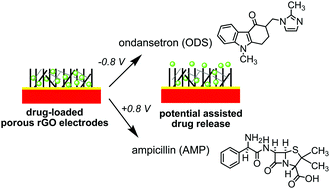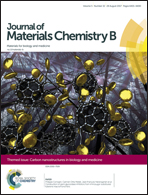On demand electrochemical release of drugs from porous reduced graphene oxide modified flexible electrodes†
Abstract
Despite the advantages of an electrochemical control for drug release, only a handful of electrochemical-based release systems have been developed so far. We report herein on the development of an electrochemically activatable platform for on-demand delivery of drugs. It is based on flexible gold thin film electrodes coated with porous reduced graphene oxide (prGO) nanosheets onto which the drug of interest has been integrated beforehand. Two different drugs are investigated here: ondansetron hydrochloride (ODS), a selective 5-HT3 receptor antagonist used for preventing nausea and vomiting caused by chemotherapy and radiotherapy, and ampicillin (AMP), an antibiotic to prevent and treat a number of bacterial infections such as respiratory tract infections, urinary tract infections, and meningitis. In the case of ODS, application of a negative potential bias of −0.8 V results in a sustained slow ODS release with an ODS flux of 47 μg cm−2 h−1. In the case of AMP, we show that polyethyleneimine modified prGO (prGO/PEI) is an extremely efficient matrix. Upon the application of +0.8 V, 24% of AMP could be released from the electrical interface in a time span of 2 h. The released AMP kept its antibacterial activity as demonstrated by antimicrobial tests. These examples illustrate the major benefits of the developed approach for biomedical applications.

- This article is part of the themed collection: Carbon Nanostructures in Biology and Medicine


 Please wait while we load your content...
Please wait while we load your content...